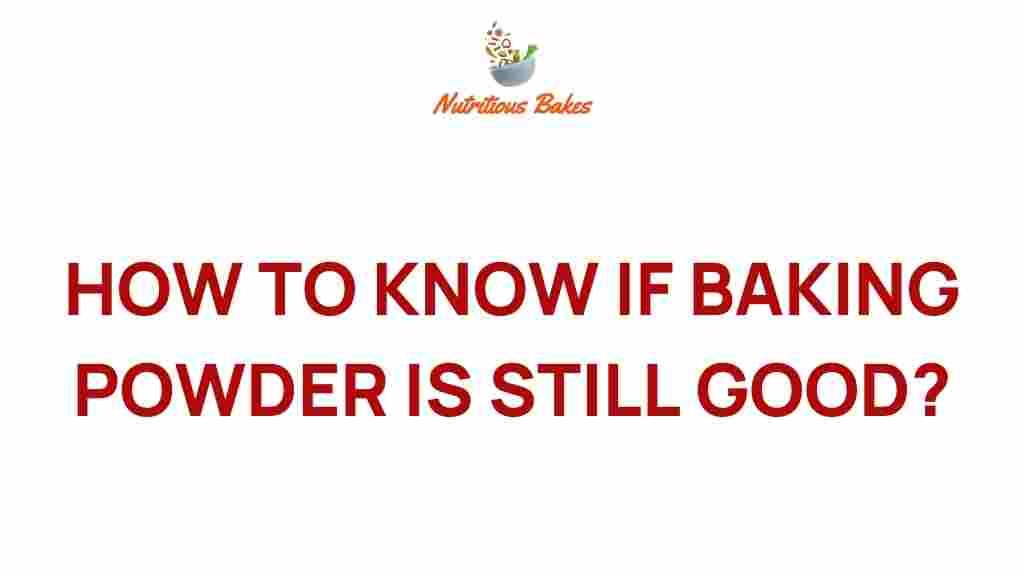Is Your Baking Powder Still Good? Freshness Test for Your Kitchen Staples
Baking powder is one of the essential leavening agents in baking, playing a crucial role in the texture and rise of your baked goods. However, like all cooking essentials, it doesn’t last forever. Knowing how to check the freshness of your baking powder can save your recipes from failure. In this article, we will explore the importance of freshness in baking powder, provide a simple freshness test, and share some valuable baking tips to ensure your pantry is stocked with reliable ingredients.
Understanding Baking Powder
Baking powder is a combination of a leavening agent (usually sodium bicarbonate), an acid (such as cream of tartar), and a moisture-absorbing ingredient (like starch). It works by releasing carbon dioxide gas when it comes into contact with moisture and heat, causing your baked goods to rise. However, if your baking powder is old or has been stored improperly, it may not work effectively, leading to dense and unappetizing results.
Why Freshness Matters
The freshness of your baking powder is vital for successful baking. Using expired or ineffective baking powder can result in:
- Dense baked goods: Without proper leavening, cakes and breads may not rise as expected.
- Inconsistent results: Recipes may yield different outcomes depending on the potency of the baking powder used.
- Wasted ingredients: Expired baking powder can lead to failed recipes, wasting time and money.
How to Perform a Freshness Test on Your Baking Powder
Performing a freshness test on your baking powder is quick and easy. Follow these steps to determine if your baking powder is still good:
Step 1: Check the Expiration Date
First, look at the packaging for an expiration date. Most baking powders have a shelf life of about 6 to 12 months after opening. If the expiration date has passed, it’s best to conduct a freshness test or replace it.
Step 2: Gather Your Materials
To perform the freshness test, you’ll need:
- 1 teaspoon of baking powder
- 1/3 cup of hot water
Step 3: Mix and Observe
1. In a small bowl, combine the baking powder with the hot water.
2. Observe the reaction. If the mixture bubbles vigorously, your baking powder is still fresh and effective.
3. If you see little to no reaction, it’s time to replace your baking powder.
Step 4: Store Properly
To maximize the shelf life of your baking powder, store it in a cool, dry place, tightly sealed to prevent moisture from getting in. Avoid keeping it near the stove or in humid areas.
Common Troubleshooting Tips for Baking Powder Issues
Even with the best intentions, you may still encounter problems when using baking powder. Here are some troubleshooting tips:
Problem: Your Baked Goods Are Flat
Possible causes:
- You used expired baking powder.
- Insufficient baking powder was used.
- Your baking powder reacted prematurely with wet ingredients.
Solution: Always perform a freshness test before baking and measure accurately.
Problem: Your Baked Goods Have a Bitter Taste
Possible causes:
- Too much baking powder was added.
- Using baking powder that contains aluminum, which can impart a metallic taste.
Solution: Follow the recipe closely and consider using aluminum-free baking powder.
More Baking Tips for Your Kitchen Staples
Ensuring the freshness of your baking powder is just one aspect of successful baking. Here are additional baking tips to keep in mind:
1. Stock Your Pantry Wisely
Keep your pantry stocked with essential ingredients, including:
- Flour (all-purpose, whole wheat, or specialty flours)
- Sugars (granulated, brown, powdered)
- Baking soda and baking powder
- Salt
- Vanilla extract and other flavorings
2. Label and Date Your Ingredients
Consider labeling and dating your pantry staples when you open them. This simple practice can help you track freshness and avoid using expired products.
3. Conduct Regular Pantry Checks
Make it a habit to perform regular pantry checks to ensure your ingredients are fresh and organized. This practice can save you time and frustration when you’re ready to bake.
4. Experiment with Substitutes
If you find yourself without baking powder, you can create a substitute using baking soda and vinegar or lemon juice:
- For every teaspoon of baking powder needed, use 1/4 teaspoon of baking soda plus 1/2 teaspoon of vinegar or lemon juice.
5. Stay Informed About Food Safety
Understanding food safety is crucial in the kitchen. Always check for signs of spoilage, and when in doubt, throw it out. Using ingredients that are past their prime can lead to foodborne illness.
Conclusion
In conclusion, ensuring that your baking powder is fresh is vital for successful baking. By performing a simple freshness test and following best practices for storage and pantry management, you can avoid baking disasters and enjoy delicious results every time. Remember that baking powder is just one of many kitchen staples you should keep an eye on. Stay proactive in checking your pantry and maintaining the quality of your ingredients.
For more tips and tricks on baking and cooking, check out this helpful resource on baking basics. And remember, a well-stocked pantry leads to endless culinary possibilities!
This article is in the category Tips and created by NutritiousBakes Team
